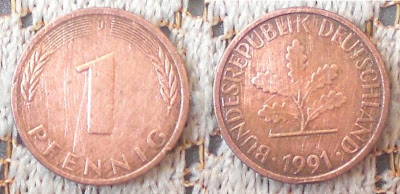The pfennig was the currency of Germany before the introduction of the Euro. It has been circulated from the 9th century to the introduction of the Euro in 2002, when it ceased to be legal tender. The name Pfennig was derived from the British penny .
In the 9th century, Charlemagne declared that 240 Pfennigs should be minted from a pound of silver. A single coin thus contained 1.5 to 2 grams of silver. Until the 13th century, the pfennig was made from real silver, and thus of high value. From the 12th century on, the King was no longer able to enforce the regalia to mint coins, so many towns and local lords made their own coins, mostly using less valuable metals and less metal per coin, so different Pfennigs had different values. Some renowned coins are the Häller Pfennig, some centuries later called Heller and minted throughout the country, and the Kreuzer (from 'Kreuz', the cross minted on the coins). In the late 17th century the Pfennigs had lost most of their value. The last Pfennig coins containing traces of silver are rarities minted in 1805.
one pfennig,1991

Weight: 2gm
Metal: copper plated steel
Diameter: 16.5mm
Obverse: five oak leaves, date below, 'bundesrepublic deustchland' meaning the federal republic of Germany
Reverse: denomination
Diameter: 18.5mm
Metal: brass plated steel
Obverse: five oak leaves, date below, 'bundesrepublic deustchland' meaning the federal republic of Germany
Reverse: denomination
10 pfennig, 1985

Weight: 4gm
Metal: brass plated steel
Diameter: 21.6mm
Obverse: five oak leaves, date below, 'bundesrepublic deustchland' meaning the federal republic of Germany
Reverse: denomination
The significance of the oak leaves: The oak tree is the national tree, a symbol of Germany. Thick woodland is the sort of image that Germany has had for many centuries, with about one-third of the country still being forested. German history is full of lores related to the woods, starting with the German tribal chieftain Hermann, also known as Arminius to the Romans, defeated the invading German legions in the murky forests of Teutoburg. Just as we have a stereotype of a sandy place for the word "Arabia", similarly the Romans had a stereotype of a marshy forest for the word "Germany" for a very long time in history. Even in modern times, there are the romantics and the fairy tales of the Grimm brothers in the 19th century. The tree even finds its way into idioms and epithets like the proud German saying "firm as a German oak".
But of late, the great German oaks have been threatened by the menace of pollution. The danger to oaks is greater as compared to most other trees as oaks have a long lifespan of about 1000 years; so they tend to accumulate more poison due to pollution over the long years of their lifespan. The number of trees having damaged crowns(upper section including branches and leaves) has gone upto a record 51% due to pollution as well as parasites and other environmental conditions.




No comments:
Post a Comment